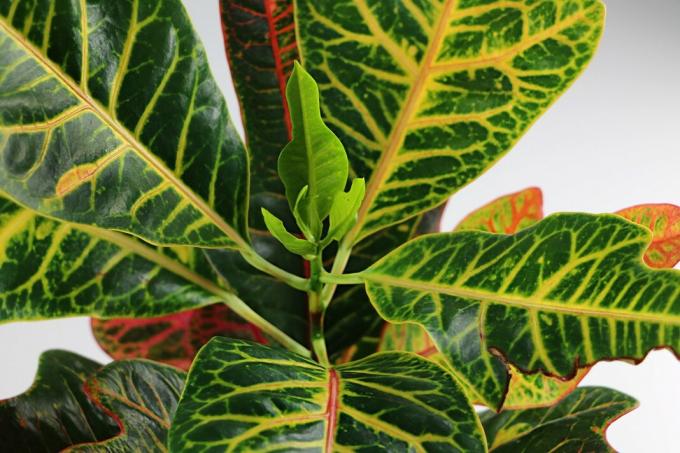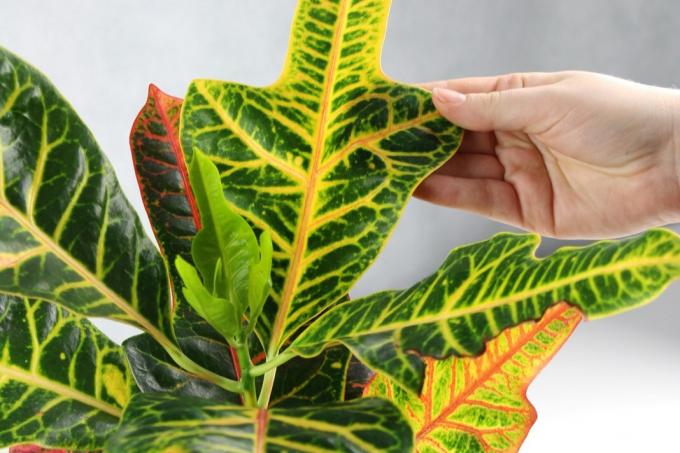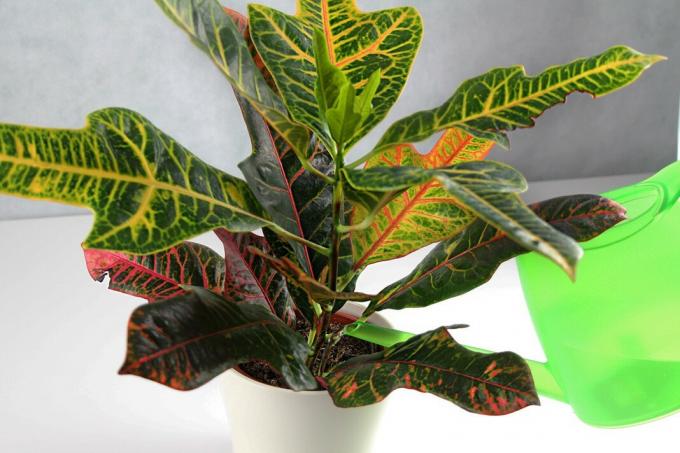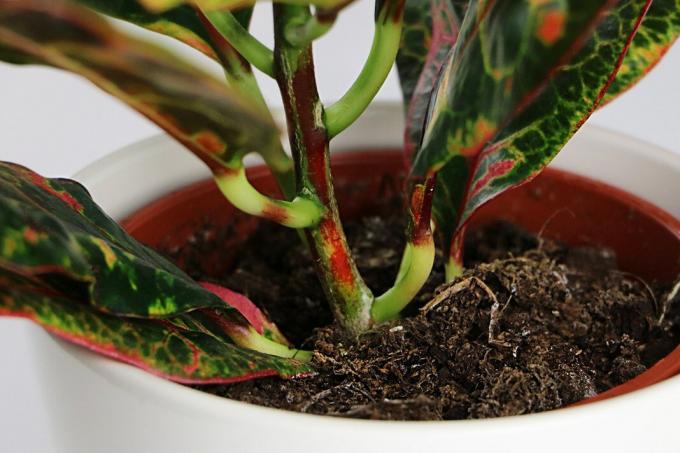
table of contents
- Growth & toxicity
- care
- Location
- to water
- Fertilize
- Cut
- Overwinter
- Multiply
- Diseases
- sorts
Profile and care information open +conclude -
- Flower color
- inconspicuous, white, green
- Location
- Negative
- Growth habit
- upright
- height
- up to 200 centimeters high
- Soil type
- sandy
- Soil moisture
- moderately moist, fresh
- PH value
- neutral
- Limescale tolerance
- Calcium tolerant
- humus
- rich in humus
- Poisonous
- Yes
- Plant families
- Spurge Family, Euphorbiaceae
- Plant species
- Potted plants, house plants
- Garden style
- Pot garden, winter garden
With its magnificent foliage in rich autumn colors, a croton (codiaeum variegatum) spreads comfort and a good mood in living rooms. The wonderful varieties of the shrub with the impressively drawn decorative leaves also act as invigorating air fresheners. No wonder that the tropical, evergreen ornamental foliage plant is right at the top of the ranking of the most popular indoor plants. These care instructions explain in detail how you can get the most beautiful out of the Croton.
Growth & toxicity
With croton, a houseplant has found its way into your home, the mighty decorative leaves of which transform any living space into a tropical refuge. The tropical Codiaeum variegatum achieves this masterpiece with a glowing play of colors in intense autumn tones and a majestic height of up to 200 cm.
The leaves, which are up to 30 cm long and 10 cm wide, filter pollutants from the room air, for the benefit of your health and vitality. So it is hardly surprising that a croton was popularly known as the miracle tree. Use detailed care instructions to find out how you can meet the exotic demands.
As a milkweed plant, the croton has a white, poisonous milky sap flowing through it. Intentional or unintentional consumption triggers typical symptoms of poisoning in humans and animals, such as nausea and vomiting. Skin contact can cause swelling and inflammation.
Note: It is therefore imperative that you wear gloves when you carry out maintenance work on the croton!
care
The croton is not one of the nursing lightweights. Mother nature certainly did not create the magnificent plant with the aim of living in the living room. Where the roots are pressed into a pot, set up in a location with a dry wind from below, the exotic wonder tree does not find ideal conditions.

Since a Codiaeum variegatum already shivers at a mild 15 degrees Celsius, life in the open air in the Central European climate - except for brief summer guest appearances - is excluded. In order to offer a Croton an acceptable home, the following care instructions come into focus. This only leads to success if all the measures outlined in it interlock harmoniously as an overall package.
Location
The choice of the location is crucial for successful maintenance. The closer the light and temperature conditions come to the conditions in its natural habitat, the more splendidly the bright colors of the leaves unfold.
- Bright to full sun location with 75 to 100 percent light intensity
- Ideally with light shade in the blazing midday sun in summer
- From March to September warm temperatures of 20 to 25 degrees Celsius
- From October to February cooler temperatures around 15 degrees Celsius
The Codiaeum variegatum, Croton guarantees the desired light output in one place on the south window sill. Here, however, you cannot do without a curtain, which softens the blazing summer sun during the midday hours. Windows that are oriented to the west, south-west, south-east or east are therefore ideally suited. A location with less light intensity fades the intense colors and robs the wonder tree of its unique beauty.
humidity
In addition to the adequate light and temperature conditions, a high level of humidity of more than 60 percent is important. Normal room climate does not meet this requirement, so that additional measures are necessary. Humidifiers or indoor fountains placed in the immediate vicinity of the plant are an excellent solution to the problem.
Bowls with water placed on an active radiator also make a contribution. If you fill the coaster with expanded clay balls and water, the evaporating moisture creates a microclimate that is pleasant for the Croton (codiaeum variegatum). In the best case scenario, assign the wonder tree to a sunny spot in the bathroom or indoor pool.
to water
The water balance is aligned with the natural vegetation cycle in the tropical climate. A croton only knows 2 seasons: a warm, rainy growth phase, followed by a cool, dry dormant period.
How to properly water the wonder tree:
- Keep the substrate slightly moist from March to September
- If the surface dries up, soak until the coaster fills up
- After a few minutes, pour out the coaster to prevent waterlogging
- Reduce the water supply from October to February without the soil drying out completely
Please use mostly filtered rainwater or stale tap water at room temperature. Cold, chalky water impairs the vitality of a Codiaeum variegatum and causes the pH value in the substrate to skyrocket, which can lead to leaf chlorosis.

Spraying
Your Codiaeum variegatum, Kroton really appreciates a gentle spray mist. Therefore, pour soft, lukewarm water into a spray bottle every day to wet the top and bottom with it. This measure also ensures that the desired humidity is maintained. During the winter heating season, this precaution also acts as an effective defense against pests such as the dreaded spider mites.
Fertilize
This part of the care instructions is particularly easy to use. Fertilize a croton (codiaeum variegatum) every 14 days from March to August with a liquid fertilizer for green plants. It is important to note that you do not apply the agent on dried substrate, but rather pour a little clear water first.
Cut
Targeted pruning should be the exception with your croton. Due to the abundant flowing latex, there is a risk that the plant will bleed out after a cut. However, if the miracle tree grows over your head, cut back too long shoots at the end of the winter break.
The cuts are washed off with warm water and then dusted with rock flour or charcoal ash. Please consider the poisonous content of the plant sap and carry out the work with protective gloves.

Note: Please do not cut out withered leaves. As soon as the croton has absorbed the nutrient residues in it, it releases a dead leaf so that it is simply plucked out.
Overwinter
From October to February the miracle tree falls into a winter dormancy.
This process requires the following modifications in the maintenance program:
- the winter location is bright and cool, with temperatures between a minimum of 13 and a maximum of 18 degrees Celsius
- Water the croton less and do not fertilize
- continue to spray regularly with lime-free water
A place directly above an active radiator is therefore unsuitable to guide the croton (codiaeum variegatum) through the cold season without damage. In this phase it is better to place it on the sunny windowsill in the unheated bedroom or in a light niche in the cool stairwell.
Repot
Get your croton (codiaeum variegatum) out of winter quarters in March and take a closer look at the pot. Once the roots have developed in such a way that the first strands grow out of the opening in the floor, it is time to move to a larger container. As a substrate, we recommend a structurally stable, compost-based, low-peat plant soil. The addition of expanded clay or lava granules improves permeability.
This is how the procedure works stress-free for both the plant and the gardener:
- Create a drainage in the new pot over the water drain made of potsherds or expanded clay
- Lay an air and water-permeable fleece over it so that the drainage material does not become silted up
- Fill in a first layer of the substrate in order to place the potted root ball in the middle
- Repeatedly press down the potting soil during filling so that no cavities form
Measure the planting depth so that the croton is no deeper than before. A pouring rim prevents the water-soil mixture from spilling over when you water it frequently. The used substrate should be removed as completely as possible after potting. Take this opportunity to take a close look at the root ball to cut out dead root strands.

Multiply
The classic cuttings method is recommended for the offspring of other Codiaeum variegatum, croton. With this variant of vegetative propagation, you use young plants that have properties that match those of the mother plant.
This is how you do it:
- during dormancy cut head cuttings with a length of 10-15 cm
- put the cuttings in a glass with water for 1-2 days so that the interfaces bleed out
- Then place the cuttings individually in pots, filled with a mix of cactus soil and sand
Pour the potting soil until water runs into the coaster. Now put a transparent cover over each pot to give the cuttings a warm, humid microclimate. Small wooden sticks serve as spacers so that the material does not touch the parts of the plant and cause decay there.
In the partially shaded window seat, the rooting progresses rapidly at 25 degrees Celsius. If an offshoot is freshly sprouting, the hood can be removed. Water regularly over the next 5 to 6 months as a strong root system develops.
Diseases
Despite its foreign origin, a croton (codiaeum variegatum) proves to be pleasantly resistant to plant diseases. What at first glance appears to be an illness is usually the result of neglect of care.
The following overview gives you the most common malicious images with tips on how to rectify them:
- Shedding of leaves: The plant is too dark and should be relocated to a sunny place
- Leaf shedding from below: Cold draft hits the location
- Fading colors: The light intensity is well below 75 percent, so a change of location makes sense
- Wilted, brown leaf tips: Too low humidity requires daily spraying with soft water
If the colorful ornamental leaves gradually turn green, it is neither a disease nor a care mistake. Rather, the variegated-leaved hybrids strive to adopt the green foliage of their wild species. You can stop this process by consistently cutting out the green leaves. Please make sure in advance that the greening is not due to a location that is too dark.
Pests
The poisonous milky sap does not protect a croton from infestation with pests. Crippled leaves indicate infestation with sucking insects, such as Aphids, Mealybugs and mealybugs. At the first signs of a pest infestation, the affected wonder tree should be isolated from the other houseplants in order to prevent the spread.
In the early infestation stage, shower the pests off with a powerful jet of water. Aphids are effectively combated with a mix of 1 liter of water and 1 tablespoon of soft soap. Stubborn mealybugs and mealybugs can be wiped off with an alcohol-soaked cloth. Under high infestation pressure, you pack the croton in an airtight plastic bag for 3 to 4 days so that the pests run out of air.

sorts
Recommended varieties
The Codiaeum variegatum, Croton was the inspiration for some splendid hybrids, which, thanks to the shapely leaf variants and blazing color nuances, awaken the passion for collecting in the creative hobby gardener. The following selection presents successful varieties in more detail:
Aucubifolium (Codiaeum variegatum var. pictum 'Aucubifolium')
The premium variety impresses with its elliptically shaped leaves. Dark yellow leaves are decorated with green dots, while predominantly green leaves are dotted with yellow dots.
Bruxellense (Codiaeum variegatum var. pictum 'Bruxellense')
The sword-shaped foliage sets itself in scene at a young age with bronze-colored tones. Over the years, the leaves gradually turn dark red.
Reidi (Codiaeum variegatum var. pictum 'Reidi')
The color green initially dominates the oval, elongated leaves. Following the subtle start, yellow, red and pink nuances join in. The spectacle becomes spectacular when the strong leaf veins turn orange and red.
Yellow Thai (Codiaeum variegatum var. pictum 'Yellow Thai')
With almost circular, strong leaves, this miracle tree impressively demonstrates that the colors green and yellow can practice artistically valuable nature painting.
Gloriosum superbum (Codiaeum variegatum var. pictum 'Gloriosum superbum')
Its broad, green leaves thrive with wavy edges that turn yellow. The leaf veins, which are also yellow in color, have a very decorative effect. The tapering leaf ends, which can loop around each other as they grow, provide a noticeable accent.


